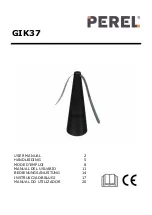
27/04/04 ©
Söring
Users manual RF-units
1
not valid for MBC600
-8-
3. Physiological and physical fundamentals of RF Surgery
Thermocautery as an aid to mechanical operation techniques began many years ago with the
application of heated metal tools to wounds to control bleeding. The technique was found to be
very effective. Later the use of electrical power to effect electro-cauterization and cutting of
tissue was the next logical step. RF Surgery is the use of high frequency alternating electrical
current (frequency higher then 300 kHz) with the purpose of alteration or destruction of cells and
for cutting tissue. It is used for tissue removal and cauterization in connection with mechanical
operation techniques. The tissue cauterization and cutting effects are accomplished by a
combination of heating through the electrical resistance offered by the biological tissue and
through the heating of the electrode.
3.1. Heating effect of RF currents in biological tissue
The heat production is mainly a result of the fact that biological tissue acts as an electrical
resistor for frequencies normally used during RF surgery and that as an electrical resistor
biological tissue heats up when electric currents flow through.
The amount of heat developed is therefore dependent on the current and the resistance of the
conductor (the biological tissue) put up by the patient.
From the electrical point of view the patient is the conductor. The material of the conductor and its
geometrical shape influences the resistance of this conductor. In this connection a comparison of
specific resistance of metallic conductors and biological tissue is of interest. Table 3.1 clearly
shows that the specific resistance of metals is much smaller than that of biological tissue. As a
result, in a closed current loop of metallic conductors and biological tissue of equal cross
sectional area the biological tissue heats up significantly more. As can be seen in the table below,
different biological tissue types offer a wide range of electrical resistance and thus are affected
differently by the applied RF signal. The MBC internal circuitry automatically senses the resistivity
and adjusts the RF signal accordingly for the best results.
Biological Tissue [
Ω
.
cm]
(in the range 0.3 to 1 MHz)
Metal [
Ω
.
cm]
blood
160
muscle, kidney, heart
200
liver, spleen
300
lung
1000
fat
3300
silver
0,0000016
copper
0,0000017
gold
0,0000022
aluminum
0,0000029
Table 3.1: Comparison of specific resistance of metals and biological tissue
The desired thermal effect should be accomplished within a small area in front of the active
electrode. Conditions for RF heating are areas with small cross-sectional area and low electrical
conductivity.
The actual temperature at the contact area between the active electrode and tissue results from
the energy balance. The energy supplied is influenced by:
-Current per area (dependent on specific resistance of the tissue and the shape of the
electrode).
-Effective time (the time that the RF current acts on the tissue area as determined by the
electrode type and velocity of the electrode over the tissue).
-Current shape (full power, alternation of power, or changing power levels)
The conducted heat is influenced by:
-The condition of the tissue, particularly at any given moment of the application cycle because
the local thermal conductivity changes as tissues are destroyed.
-Temperature, because additional energy is needed for vaporization of tissue fluid.








































